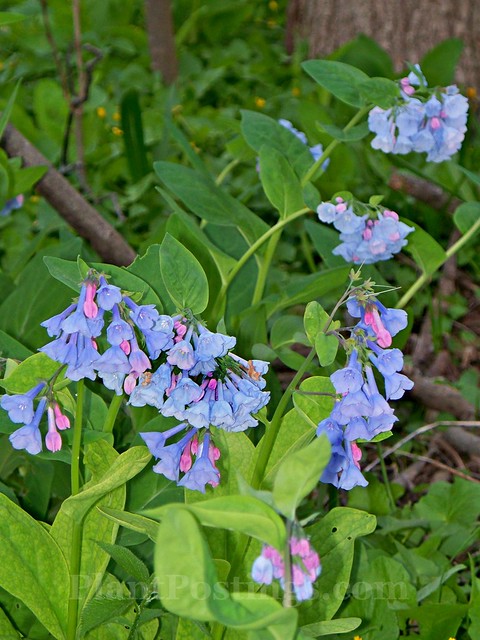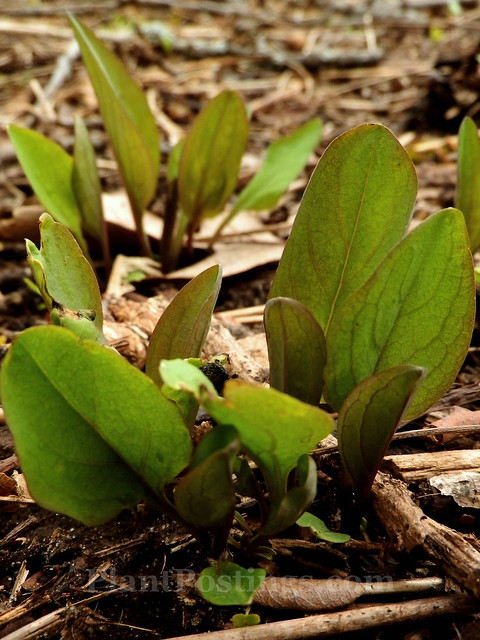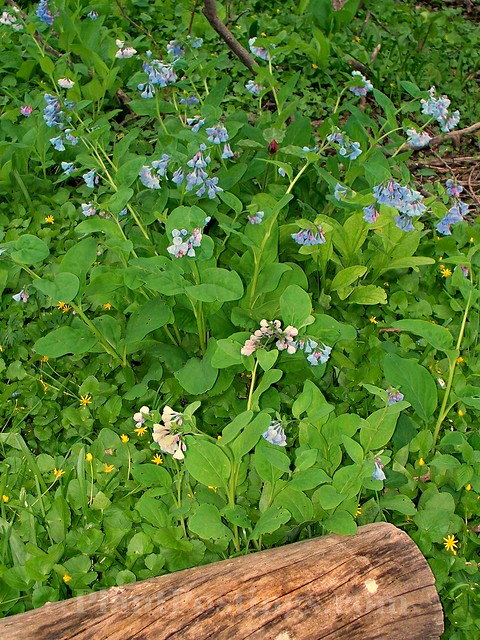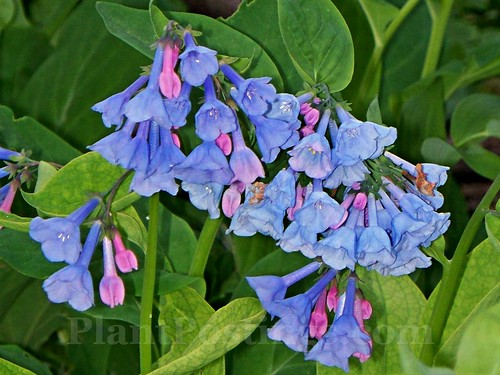
It's Wildflower Wednesday, and of course there are no wildflowers blooming in my USDA zone 5a garden in January. In fact, this plant has never bloomed in my garden.

I planted Virginia Bluebells (Mertensia virginica) from seed in the fall of 2013. Every year, I find more plants along the edge of our little woodland, but after five years, they haven't bloomed. Perhaps the rabbits are eating the tiny buds before they have a chance to flower, though I've read it's a rabbit-resistant plant.

I won't give up, because I'm hoping eventually they'll colonize among the Trilliums, Bloodroot, Spring Beauties, and the other spring ephemerals. Virginia Bluebells are native here, and I've seen them many times in nearby forests, parks, and nature centers.
Virginia Bluebells are native to much of eastern North America--from Maine and Georgia westward through Minnesota and Kansas, according to the Lady Bird Johnson Wildflower Center.
The plants emerge in early spring, and often have a slight reddish tinge to the foliage until they grow larger. Maximum height is about two feet. In the wild, they grow in moist woods and clearings and along river edges. They prefer part shade or full shade and rich soil. Buds begin pink and open to an exquisite blue, for which photos simply can't do justice.
Will this be the year Virginia Bluebells bloom in my woodland garden? Time will tell. Until then, I'll dream about them and look forward to seeing them somewhere nearby as winter fades to spring.

I'm linking this post to Gail's Wildflower Wednesday meme at Clay and Limestone. Head on over to learn about other wildflowers in gardens and wild places around the world.
How frustrating that they won't bloom! They are so lovely. You know they don't like my dry shade! Happy WW. xoxo
ReplyDeleteYes, it is. Apparently, they can take some time to settle in. I hope it will happen soon. ;-) Some of my shade is pretty dry, too, depending on the year. But other years it can be quite wet--especially in the early spring. Thanks for hosting the meme, Gail!
DeleteI wonder if they have to mature for several years before blooming, as do many perennials and shrubs. I have seen photos of woodlands filled with these plants, and I swoon over them. They are so pretty!
ReplyDeleteThat's what some folks are saying. I'm trying to be patient. ;-) I agree: I love happening upon a large patch of them--they're simply stunning, even though they have a short life above ground each year.
DeleteThis is certainly one to add to my list as I'm keeping an eye out for plants that will perform in the shady north facing beds by my front entrance. I'm glad that they can be grown from seed and that is definitely the route I will take. First things first though - I'm still trying to clear the bed of sweet woodruff that has essentially taken over and hopefully, this will be the year when I win that battle.
ReplyDeleteI would think they'd be excellent for that location, Margaret! Yes, I should have mentioned this might be a good time of year to sow the seeds, since they need cold stratification. I hope yours will bloom. It's funny, I remember not long ago when Sweet Woodruff was the plant to have for a shade garden--shows how troublesome nonnative invasives can be. Good luck!
DeleteI dream of having swaths of Virginia bluebells throughout my woodland. Alas, I haven't had any luck getting them established. I'll keep trying, amending the soil to get more loamy richness they like. I hope yours will bloom for you this year.
ReplyDeleteI have the loamy soil, and the shade, and the other conditions they supposedly like. Hopefully, one of these days we'll both have blooms. ;-)
DeleteI always admire these plants, flaunting blue and pink tones at the same time. I'm well outside their zonal stretch, however, so this is one of the many plants that sits on the long list of beautiful plants I can't grow.
ReplyDeleteYes, that stage when they're pink and blue is really pretty, isn't it? I guess there are some benefits of living in a cold climate. But you can grow so many things that I can't, and in a warm comfortable climate year-round. :)
DeletePollinators must love those. I hope they bloom for you Beth
ReplyDeleteYes, I'll bet they do. Thanks, Michelle. Each spring when I see the little plants poking out of the ground I get hopeful for blooms. Maybe this will be the year.
DeleteJust seeing the leaves popping out of the ground makes my heart go pitty patter. I can hardly wait for those beautiful blue and pink blooms.
ReplyDeleteI agree, Lisa. :) I hope one of these days, I'll get the blooms, too.
DeleteOh so pretty . . .
ReplyDeleteHope some bluebell blooms appear this spring . . .
Aren't they lovely, Lynne?! I'll keep the hope going, and of course I'll post about them blooming, if it ever happens.
DeleteSuch pretty flowers! Hope some appear on your plants this spring!
ReplyDeleteI know--the shades of pink and purple are so sweet. Fingers crossed!
DeleteDefinitely a plant for a woodland setting where you don't have to figure out what to plant them with for the rest of the season. I love the early foliage on them.
ReplyDeleteYes, I sowed the seeds in an area of the garden that has other ephemerals, and then in mid- to late summer the ferns and sedges take over. I agree--the early foliage is nifty.
DeleteDon't give up on them! They are worth the wait.
ReplyDeleteI won't. I agree: they're beautiful bloomers. :)
DeleteI absolutely LOVE Va. bluebells. When we lived in Pennsylvania I saw large clumps of them growing on stream banks. I've grown them here too. I love the leaves, I love the pink buds, and the blue nodding flowers are divine. The white form is beautiful too. I hope yours bloom soon!
ReplyDeleteI've come across patches of them in the wild at times, too. Very pretty. They're so special, particularly because their spectacular show is so short.
DeleteThey are lovely. I hope yours will bloom.
ReplyDeleteCarla
I know! Me, too, Carla!
Deletesleep creep leap??
ReplyDeleteThat pink and blue of morning glory or our Lobostemon is such a happy pair!
Yes, I hope you're right, Diana. I'm getting a little impatient, but I won't give up. Agreed that Morning Glories have that same lovely pink and blue combo. I see what you mean about your Lobostemon fruticosus. It's a lovely bloomer, too!
DeleteI remember attending a talk last year on bees and the speaker mentioning Virginia bluebells as an important food source for them in early spring. I don't have any in my garden either, Beth, but I just ordered some, so I hope to have some blooming next year. Hope this will be the year yours finally bloom!
ReplyDeleteGood to hear, Rose. They are lovely. I'm hoping Diana is right that they will sleep, creep, and then leap (and bloom) in my garden. Right now, I'm at the creep stage. Good luck with your new plants! I'll look forward to seeing lovely pictures and a report on your blog. :)
DeleteVirginia Bluebells are on my list to research. I love them and what a plus that they multiply like that.
ReplyDeleteYes, they are nifty! Let me know what you decide, and if you plant them, I'll look forward to reading about them/seeing them on your blog. :)
DeleteI hope you will get bluebells this year. The photos are a delight and they make me wonder if I have a place for bluebells.
ReplyDeleteThanks, Pat. The plants are really awesome. In person, they're so pretty, they almost look unreal. Hardy to describe. You will like them, and I think they would like your garden. :)
DeleteThey are beautiful and I am not surprised at all that you would like to see them again blooming. Regards.
ReplyDeleteYes, of course, Giga. :) It will be a while (2-3 months), but I hope they will bloom this year. Such pretty flowers.
DeleteI have one clump that I planted a number of years ago. I don't remember if it bloomed the first couple of years, but am thinking it did. The clump is a bit larger than when first planted, but it has not spread much. I hope your plants bloom this year!
ReplyDeleteThanks, Sue. I wonder if the fact that you have a little more sun helped yours to bloom earlier? My garden is mostly a woodland, so it gets lots of late winter/early spring sun, and then mostly shade. But that's where V. Bluebells bloom in nature--along woodland edges, Oak openings, and Oak savannahs. One of these years...
DeleteNo sure how I missed this post, but those a gorgeous plants and photographs. I have some photos of a (probably?) related flower that I saw on hikes in the Rockies a few years back.
ReplyDeleteHi Tina. Thanks! I love Virginia Bluebells, and I hope they'll fill in here eventually. The native range doesn't stretch beyond Nebraska and Kansas, but perhaps you saw the related Mountain Bluebells (Mertensia ciliata)? They do look similar.
DeleteWhen I learned to not cultivate/hoe the beds in which I had planted Virginia Bluebells the self-seeding and spreading of their rhizomes took off. I now have ever-increasing patches of these lovely plants in our USDA Zone 4 moderately-shaded beds. As a reminder tool (as I accommodated to their sensitivity to shallow weed-elimination soil disturbance) I inserted inscribed markers with "No Hoe Zone" prominently placed in the areas around my 'parent plants'. My beds are now heavily mulched with arborists' wood chips to minimize weeding activity and allow the Virginia Bluebell's seeds to germinate and to form their rhizomatous roots. Virginia Bluebells do not produce any visible leaves in their first year of life so the "No Hoe Zone" reminder stake was a crucial reminder after the plants had gone dormant to not disturb the soil where the seedlings were getting established.
ReplyDeleteHi Phil: I don't cultivate this area of the garden much at all. I simply scattered the seeds and very lightly covered them with soil and marsh hay. I think I scattered them in the fall, and by the next spring the foliage made an appearance. But no blooms...until this year! Yay! And the root system seems to be spreading in that area of the garden!
Delete